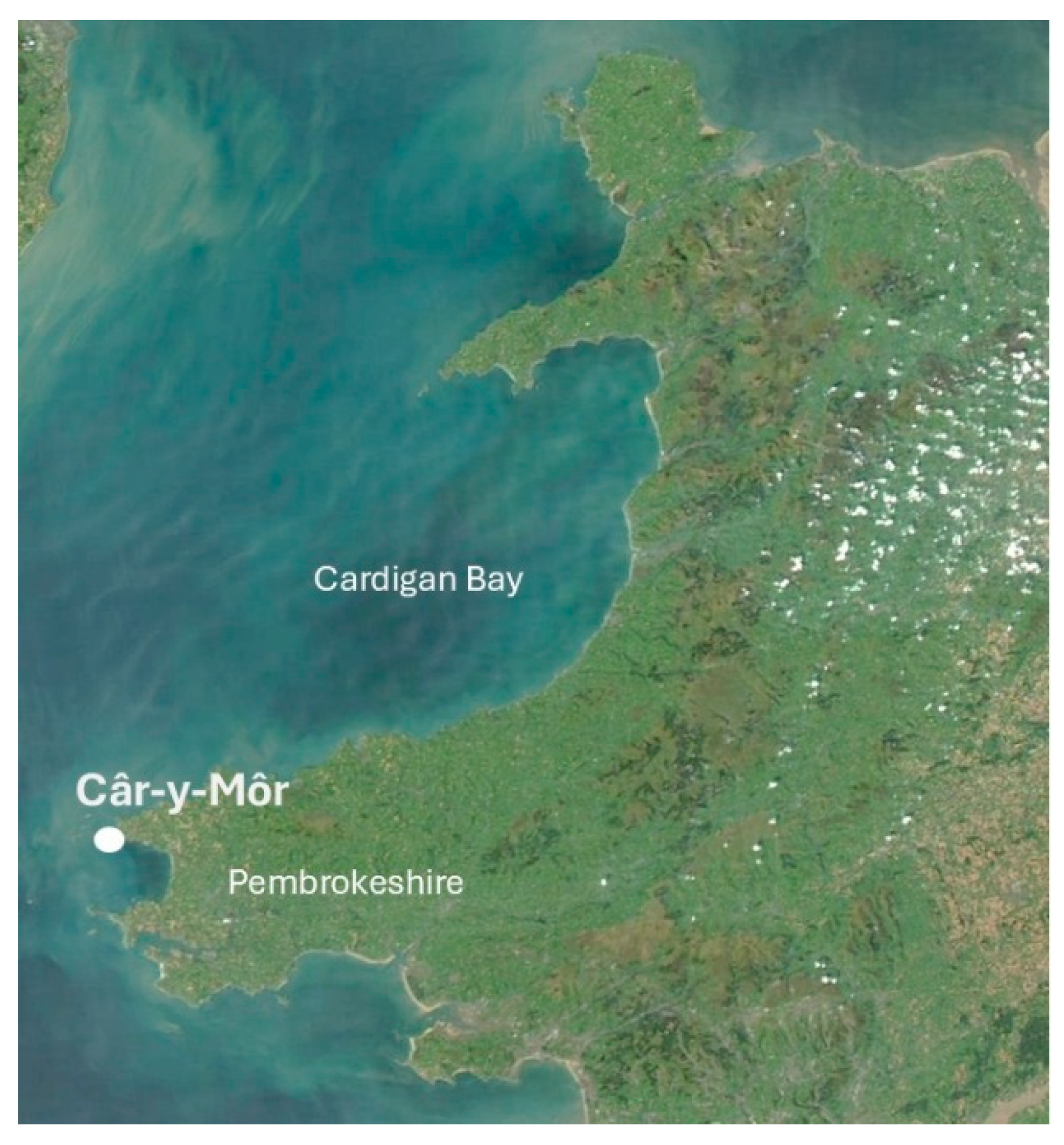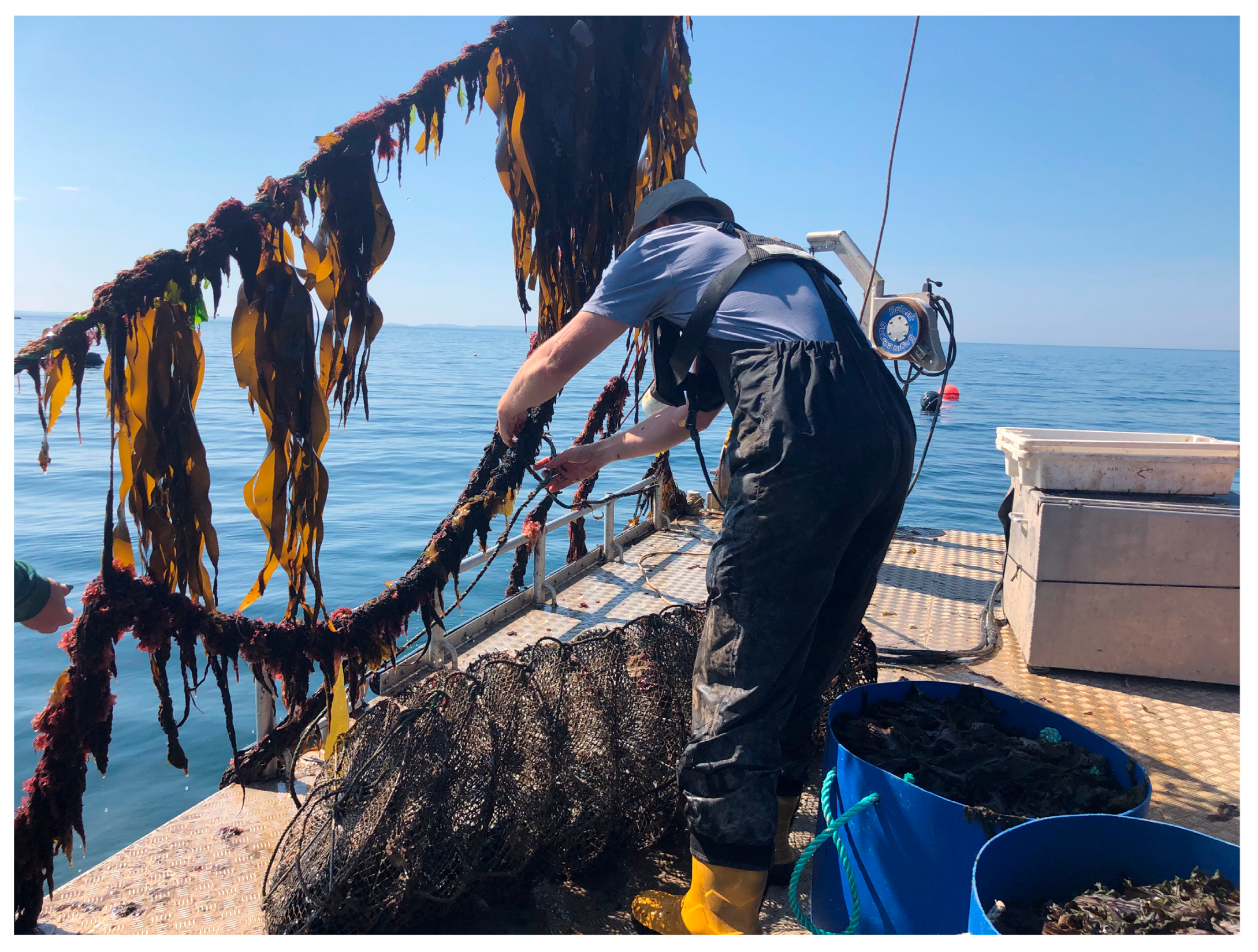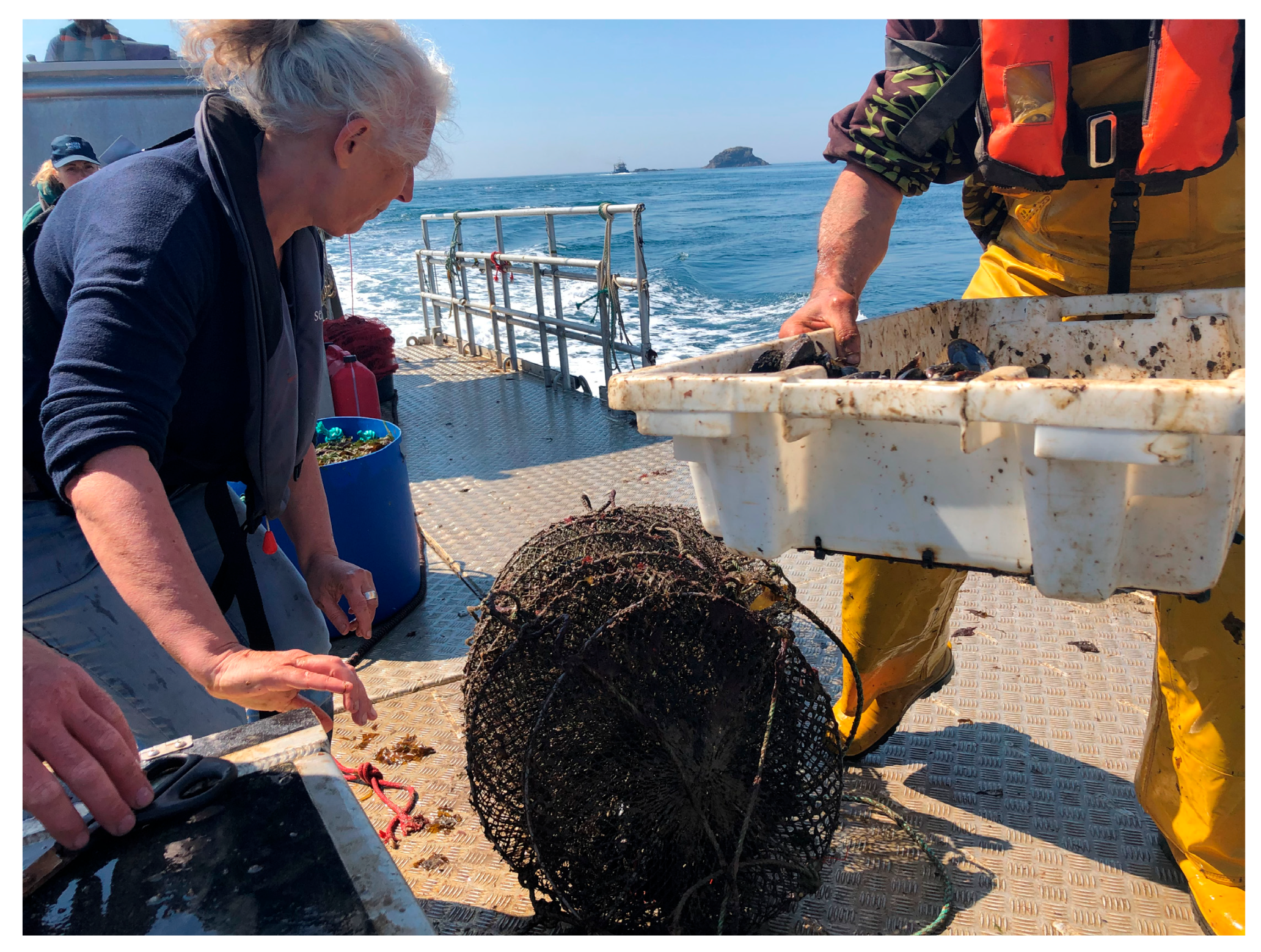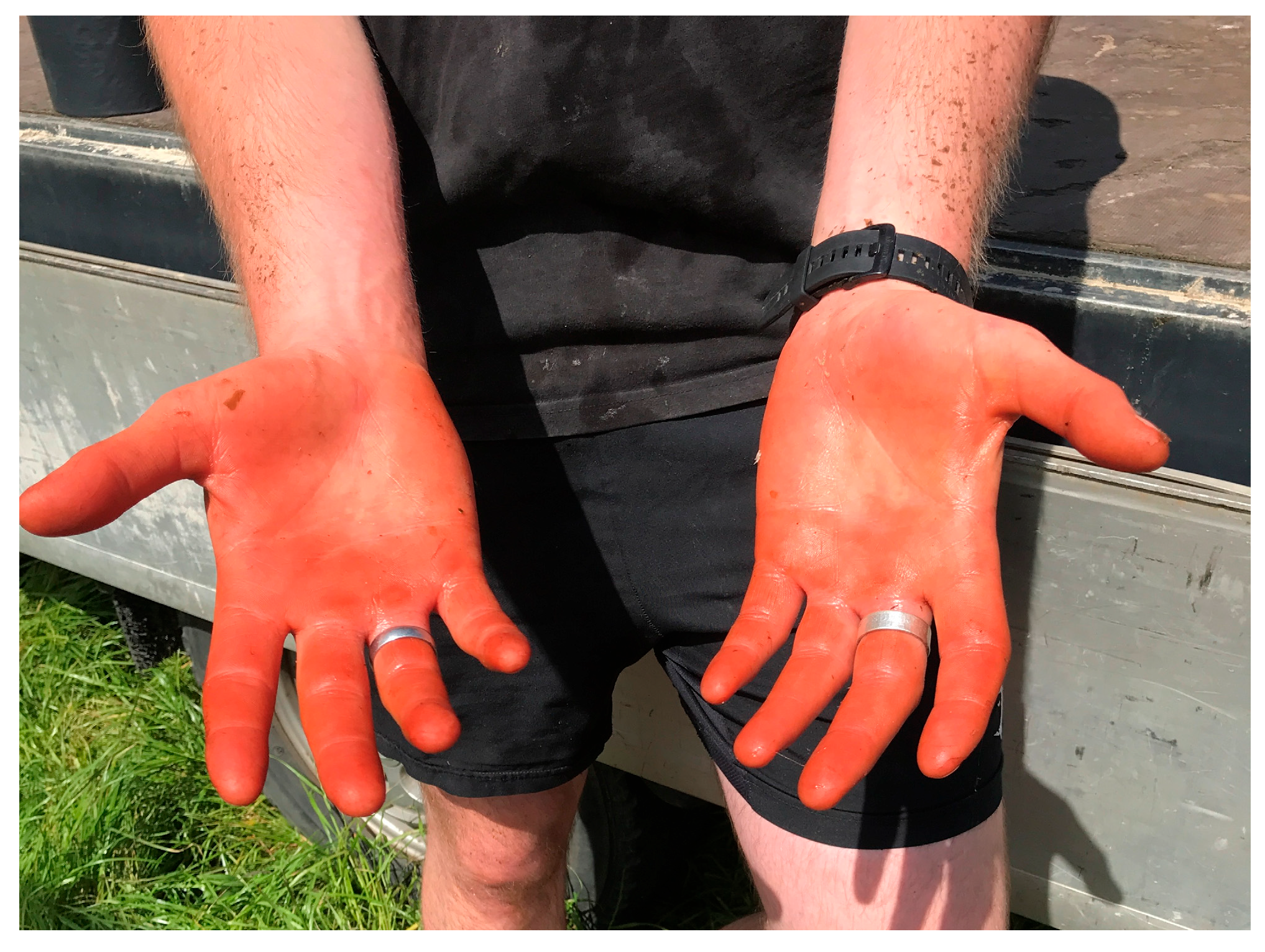For the Love of the Sea: Technocratic Environmentalism and the Struggle to Sustain Community-Led Aquaculture
Abstract
1. Introduction
- How does technocratic environmentalism shape the governance of regenerative aquaculture at Câr-y-Môr?
- How do community practitioners negotiate bureaucratic demands while sustaining ecological and ethical care?
- What forms of governance might better support adaptive, relational, and context-sensitive approaches to marine sustainability?
2. Background
2.1. Technocratic Environmentalism and the Transformation of Governance
2.2. Case Context: Câr-y-Môr, a Community-Owned Regenerative Ocean Farm
3. Methodology: Ethnographic Research Design
Participant Observation
4. Ethnographic Narratives at Câr-y-Môr
4.1. Regulations and Bureaucratic Burdens
4.2. Embodied Learning and Practice Amid Bureaucratic Systems
4.3. Scaling and the Internalisation of Bureaucratic Care
5. Discussion: Negotiating Governance Through Care, Time, and Practice
5.1. Reconnecting Governance and Practice
5.2. Embodied Knowledge and the Politics of Care
5.3. Temporalities of Governance
5.4. Scaling, Labour, and Organisational Frictions
5.5. Transformative Governance and Learning from Practice
6. Lessons from Câr-y-Môr
6.1. Proportionate and Responsive Regulation
6.2. Recognising Local and Embodied Knowledge
6.3. Creating Space for Experimentation and Learning
7. Conclusions
Supplementary Materials
Author Contributions
Funding
Institutional Review Board Statement
Informed Consent Statement
Data Availability Statement
Acknowledgments
Conflicts of Interest
Abbreviations
| ASA | Association of Social Anthropologists |
| DEFRA | Department for the Environment, Food and Rural Affairs |
| MCA | Marine and Coastguard Agency |
| NRW | National Resources Wales |
| THiSS | Transdisciplinary Humanities-Informed Sustainability Science |
References
- Suding, K.N.; Higgs, E.; Palmer, M.A.; Callicott, J.B.; Anderson, C.B.; Baker, M.; Gutrich, J.J.; Hondula, K.L.; LaFevor, M.C.; Larson, B.M.H.; et al. Committing to ecological restoration. Science 2015, 348, 638–640. [Google Scholar] [CrossRef] [PubMed]
- Unsworth, R.K.F.; Butterworth, A.; Cullen-Unsworth, L.C.; Garforth, L. Restorative aquaculture and the governance of learning, enabling innovation in marine sustainability. Mar. Policy 2025, in press. [Google Scholar]
- Li, T.M. The Will to Improve, Governmentality, Development, and the Practice of Politics; Duke University Press: Durham, NC, USA, 2007. [Google Scholar]
- Sharma, S. In the Meantime, Temporality and Cultural Politics; Duke University Press: Durham, NC, USA, 2014. [Google Scholar]
- Turnhout, E.; Dewulf, A.; Hulme, M. What does policy relevant global environmental knowledge do, the cases of climate and biodiversity. Curr. Opin. Environ. Sustain. 2018, 18, 65–72. [Google Scholar] [CrossRef]
- Tsing, A.L. The Mushroom at the End of the World, on the Possibility of Life in Capitalist Ruins; Princeton University Press: Princeton, NJ, USA, 2015. [Google Scholar]
- Cohen, P.J.; Blythe, J.; Bennett, N.J.; Allison, E.H. Securing a just space for small scale fisheries in the blue economy. Front. Mar. Sci. 2019, 6, 171. [Google Scholar] [CrossRef]
- Song, A.M.; Armitage, D.R.; Marschke, M. Revisiting governance in small scale fisheries through the lens of Indigenous and community based enterprises. Mar. Policy 2021, 132, 104672. [Google Scholar]
- Bell-James, J.; Lovelock, C.E. Legal frameworks for blue carbon restoration, international and Australian perspectives. Mar. Policy 2019, 107, 103593. [Google Scholar]
- Brugère, C.; Troell, M.; Eriksson, H.; Waidbacher, H. More than fish, policy coherence and benefit sharing as necessary conditions for equitable aquaculture development. Mar. Policy 2021, 124, 104333. [Google Scholar] [CrossRef]
- Niner, H.J.; Robertson, G.; Singh, G.G.; St. Gelais, A.T. Regenerative ocean economies, aligning policy frameworks for emerging marine industries. Mar. Policy 2024, 160, 106325. [Google Scholar]
- Horcea-Milcu, A.I.; Abson, D.J.; Apetrei, C.I.; Fischer, J. Transformative governance for sustainability, towards a relational and reflexive paradigm. Sustain. Sci. 2024, 19, 589–603. [Google Scholar]
- Haraway, D.J. Staying with the Trouble, Making Kin in the Chthulucene; Duke University Press: Durham, NC, USA, 2016. [Google Scholar]
- Puig de la Bellacasa, M. Matters of Care, Speculative Ethics in More Than Human Worlds; University of Minnesota Press: Minneapolis, MN, USA, 2017. [Google Scholar]
- Ingold, T. Making, Anthropology, Archaeology, Art and Architecture; Routledge: London, UK, 2013. [Google Scholar]
- Heckwolf, M.; Döring, R.; Schlüter, M. Regulatory sandboxes for sustainability transitions, experimental governance in environmental policy. Environ. Sci. Policy 2022, 135, 27–35. [Google Scholar]
- Jasanoff, S. States of Knowledge: The Co-Production of Science and Social Order; Routledge: London, UK, 2004. [Google Scholar]
- Scott, J.C. Seeing Like a State: How Certain Schemes to Improve the Human Condition Have Failed; Yale University Press: New Haven, CT, USA, 1998. [Google Scholar]
- Cleaver, F. Development Through Bricolage: Rethinking Institutions for Natural Resource Management; Earthscan: London, UK, 2012. [Google Scholar]
- Brugère, C.; Aguilar-Manjarrez, J.; Beveridge, M.C.M.; Soto, D. The Ecosystem Approach to Aquaculture 10 Years On, A Critical Review and Consideration of Its Future Role in Blue Growth. Rev. Aquac. 2020, 12, 543–567. [Google Scholar] [CrossRef]
- Nightingale, A.J. Nature–Society and Development, Social, Cultural, and Ecological Change in Nepal. Geoforum 2013, 50, 123–132. [Google Scholar] [CrossRef]
- Whatmore, S. Hybrid Geographies: Natures, Cultures, Spaces; Sage Publications: London, UK, 2002. [Google Scholar]
- Kaltoft, P. Governance Challenges for Sustainable Aquaculture in Europe, A Qualitative Analysis. Mar. Policy 2021, 131, 104580. [Google Scholar]
- Urquhart, J.; Acott, T.; Zhao, M.; Xiao, Y. Fishers, Farmers, and Scientists, Integrating Knowledge and Adaptive Governance for Aquaculture Sustainability. Mar. Policy 2013, 37, 85–93. [Google Scholar]
- Bush, S.R.; Belton, B.; Hall, D.; Vandergeest, P. Certify Sustainable Aquaculture, Ecological Modernisation and the Politics of Transnational Governance. Environ. Plan. A Econ. Space 2019, 51, 138–157. [Google Scholar]
- Msomphora, M.R. Understanding Stakeholder Perceptions of Sustainable Aquaculture in Tanzania, A Policy Gap Analysis. Ocean Coast. Manag. 2020, 198, 105350. [Google Scholar]
- Partelow, S.; Schlüter, A.; Armitage, D.; Bavinck, M.; Song, A.; Chuenpagdee, R. Social–Ecological Systems Research for Sustainable Marine Governance, Integrating Context and Participation. Sustain. Sci. 2023, 18, 203–217. [Google Scholar]
- Stirling, A. Keep It Complex. Nature 2010, 468, 1029–1031. [Google Scholar] [CrossRef] [PubMed]
- Brugère, C.; Aguilar-Manjarrez, J.; Soto, D.; Beveridge, M.C.M. Blue Growth and Integrated Governance, Strategies to Reconcile Aquaculture and Marine Conservation. Mar. Policy 2021, 126, 104407. [Google Scholar]
- Aronson, J.; Goodwin, N.; Orlando, L.; Eisenberg, C.; Cross, A.T. A World of Possibilities, Six Restoration Strategies to Support the United Nations Decade on Ecosystem Restoration. Restor. Ecol. 2018, 28, 730–736. [Google Scholar] [CrossRef]
- Song, A.M.; Cohen, P.J.; Hanich, Q.; Morrison, T.H. Policy Integration for Transformative Governance of Small-Scale Fisheries, Lessons from the Pacific. Glob. Environ. Change 2021, 68, 102254. [Google Scholar]
- Haraway, D. Situated Knowledges: The Science Question in Feminism and the Privilege of Partial Perspective. Fem. Stud. 1988, 14, 575–599. [Google Scholar] [CrossRef]
- Welsh Government. Aquaculture—Sector Locational Guidance: Initial Report March 2021; Welsh Government: Cardiff, UK, 2021. Available online: https://www.gov.wales/sites/default/files/publications/2022-06/aquaculture-sector-locational-guidance-initial-report-march-2021.pdf (accessed on 21 September 2025).
- Câr-y-Môr. Wales First Regenerative Sea Farm. Available online: https://www.carymor.wales/ (accessed on 15 September 2025).
- ABPmer. AWAA Aquaculture Activity Assessment: Subtidal Shellfish Aquaculture Using Ropes; NRW Evidence Report No. 725; Natural Resources Wales: Cardiff, UK, 2023. [Google Scholar]
- Lebdioui, A. Nature-Inspired Innovation Policy: Biomimicry as a Pathway to Leverage Biodiversity for Economic Development. Ecol. Econ. 2022, 202, 107585. [Google Scholar] [CrossRef]
- DEFRA. UKSF Infrastructure Scheme Projects: Grants Awarded in Round 2 of the Scheme. Available online: https://www.gov.uk/government/publications/uk-seafood-fund-infrastructure-scheme-projects/uksf-infrastructure-scheme-projects-grants-awarded-in-round-2-of-the-scheme (accessed on 21 September 2025).
- British Business Bank. Growth Guarantee Scheme: Câr-y-Môr Case Study. Available online: https://www.british-business-bank.co.uk/case-studies/car-y-mor (accessed on 21 September 2025).
- Coastal TALES. Telling Adaptations, Living Environmental Stories for Coastal Resilience. Available online: https://bridges.earth/projects/coastal-tales/1 (accessed on 29 May 2025).
- JPI. Coastal TALES: Telling Adaptations, Living Environmental Stories for Coastal Resilience. Available online: https://www.heritageresearch-hub.eu/project/coastal-tales/ (accessed on 29 May 2025).
- Attala, L.; Steel, L.; Oosterbeck, L.; Hartman, S.; Tsimprikidou, D. BRIDGES: A Humanities-Led UNESCO Coalition for Sustainability: Towards a Global Mapping of Integrated Co-produced Sustainability Science. 2023. Available online: https://bridges.earth/news/post/bridges-coalition-project-mapping-humanities-led-sustainability-science (accessed on 15 September 2025).
- BRIDGES. Innovating the Way Knowledge is Produced. Available online: https://bridges.earth/about (accessed on 15 September 2025).
- Seidl, I.; Böni, R.; Lauber, S.; Herzog, F. Developing, Implementing and Communicating Inter- and Transdisciplinary Research: AlpFUTUR as an Example. GAIA-Ecol. Perspect. Sci. Soc. 2015, 24, 188–195. [Google Scholar] [CrossRef]
- Kimmerer, R.W. Braiding Sweetgrass: Indigenous Wisdom, Scientific Knowledge and the Teachings of Plants; Penguin: London, UK, 2013. [Google Scholar]
- Geertz, C. Deep Hanging Out. N. Y. Rev. Books 1998, 45, 69–72. [Google Scholar]
- Ingold, T. The Perception of the Environment: Essays on Livelihood, Dwelling and Skill; Routledge: London, UK, 2000. [Google Scholar]
- Günel, G.; Varma, S.; Watanabe, C. A Manifesto for Patchwork Ethnography. Member Voices, Fieldsights. 2020. Available online: https://culanth.org/fieldsights/a-manifesto-for-patchwork-ethnography (accessed on 16 September 2025).
- Günel, G.; Watanabe, C. Patchwork Ethnography. Am. Ethnol. 2023, 50, 131–139. [Google Scholar] [CrossRef]
- Günel, G.; Watanabe, C.; Jungnickel, K.; Coleman, R. Everything is Patchwork! A Conversation about Methodological Experimentation with Patchwork Ethnography. Aust. Fem. Stud. 2024, 38, 211–229. [Google Scholar] [CrossRef]
- Prior, L. Using Documents in Social Research; Sage: London, UK, 2003. [Google Scholar]
- Pink, S. Doing Sensory Ethnography, 2nd ed.; Sage: London, UK, 2015. [Google Scholar]
- Seidl, R.; Brand, F.S.; Stauffacher, M. Science with Society in the Anthropocene. AMBIO 2013, 42, 5–12. [Google Scholar] [CrossRef]
- Palomera, J.; Vetta, T. Moral Economy: Rethinking a Radical Concept. Anthropol. Theory 2016, 16, 413–432. [Google Scholar] [CrossRef]
- Berlant, L. Cruel Optimism; Duke University Press: Durham, NC, USA, 2011. [Google Scholar]
- Anand, N.; Gupta, A.; Appel, H. The Promise of Infrastructure; Duke University Press: Durham, NC, USA, 2018. [Google Scholar]
- England, K.V.L. Getting Personal: Reflexivity, Positionality, and Feminist Research. Prof. Geogr. 1994, 46, 80–89. [Google Scholar] [CrossRef]
- Pillow, W. Confession, Catharsis, or Cure? Rethinking the Uses of Reflexivity in Qualitative Research. Int. J. Qual. Stud. Educ. 2003, 16, 175–196. [Google Scholar] [CrossRef]
- Association of Social Anthropologists of the UK and Commonwealth (ASA). Ethical Guidelines for Good Research Practice. 2011. Available online: https://www.theasa.org/ethics/guidelines.shtml (accessed on 15 September 2025).
- Kaltoft, P. The Relational Ethics of Seaweed Farming: Care, Maintenance, and Co-existence in Coastal Livelihoods. Mar. Policy 2021, 132, 104684. [Google Scholar]
- Msomphora, M.R. Interactive Governance of Fisheries and Aquaculture: Transdisciplinary Challenges and Stakeholder Involvement in Coastal Zone Management. Mar. Rep. (MAREP) 2024, 3, 91–110. [Google Scholar] [CrossRef]
- Partelow, S.; Asif, F.; Béné, C.; Bush, S.R.; Manlosa, A.O.; Nagel, B.; Schlüter, A.; Chadag, V.M.; Choudhury, A.; Cole, S.M.; et al. Aquaculture Governance: Five Engagement Arenas for Sustainability Transformation. Curr. Opin. Environ. Sustain. 2023, 65, 101379. [Google Scholar] [CrossRef]
- Tronto, J.C. Caring Democracy: Markets, Equality, and Justice; New York University Press: New York, NY, USA, 2013. [Google Scholar]





Disclaimer/Publisher’s Note: The statements, opinions and data contained in all publications are solely those of the individual author(s) and contributor(s) and not of MDPI and/or the editor(s). MDPI and/or the editor(s) disclaim responsibility for any injury to people or property resulting from any ideas, methods, instructions or products referred to in the content. |
© 2025 by the authors. Licensee MDPI, Basel, Switzerland. This article is an open access article distributed under the terms and conditions of the Creative Commons Attribution (CC BY) license (https://creativecommons.org/licenses/by/4.0/).
Share and Cite
Thomas, G.; Steel, L.; Attala, L. For the Love of the Sea: Technocratic Environmentalism and the Struggle to Sustain Community-Led Aquaculture. Sustainability 2025, 17, 10136. https://doi.org/10.3390/su172210136
Thomas G, Steel L, Attala L. For the Love of the Sea: Technocratic Environmentalism and the Struggle to Sustain Community-Led Aquaculture. Sustainability. 2025; 17(22):10136. https://doi.org/10.3390/su172210136
Chicago/Turabian StyleThomas, Gareth, Louise Steel, and Luci Attala. 2025. "For the Love of the Sea: Technocratic Environmentalism and the Struggle to Sustain Community-Led Aquaculture" Sustainability 17, no. 22: 10136. https://doi.org/10.3390/su172210136
APA StyleThomas, G., Steel, L., & Attala, L. (2025). For the Love of the Sea: Technocratic Environmentalism and the Struggle to Sustain Community-Led Aquaculture. Sustainability, 17(22), 10136. https://doi.org/10.3390/su172210136






